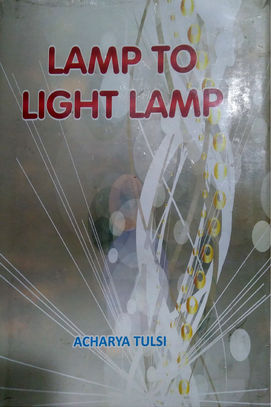While studying the Anuyogadwara Sutra, my attention was centred on the phrase, 'acharyas are like lamps.' I thought that teachers occupy a high position. They can be compared with the sun and the moon. They can be compared to the sea and the earth. Why should they be compared to lamps? Anyone can become a lamp. But then I thought that not a single syllable in the Agama can be without some meaning. Those who wrote the Agamas were persons with special insight. Anga-Agamas are written on the basis of the sermons (deshana) of the Tirthankaras. Their utterances by themselves are a testimony. Those who composed the Upangas (subsidiary texts) were monks and acharyas. Anuyogadwara Sutra which is a work of Acharya Aryarakshit is a Moola Agama. He was a Poorvadhara (a person possessed of the knowledge of the purvas, the earlier canonical texts) Acharya. Whatever he wrote, must have a serious meaning. In this process of thinking, I read it in its entire context-
A hundred lamps are lighted with one lamp. Even after lighting so many lamps, the light of this lamp does not become dim. It remains bright as ever. Acharyas, like the lamp, are themselves bright and bring light to others.*
A lamp while it burns spreads light. This is not an easy thing to do. But it is very important to light a long row of lamps with one's light. The characteristic lustre that the Acharya has is because of his knowledge, faith and conduct. It is transmitted by them to millions of people. That is why this comparison has a special significance.
The sun is a mass of light. It shines by dispelling darkness. But it has own limitation. It shines for a limited time. When the limit of time is crossed, it goes down behind the western horizon and once again there is a reign of darkness on the earth. But while disappearing behind the western horizon, it leaves behind a question-mark and wishes to entrust the responsibility of spreading light to a powerful person. But there is total silence spreading all around. No one is able to summon the necessary courage. At such a moment, a tiny lamp stood up to the situation and proclaimed with self-confidence, "You go without any worry. I shall keep awake the whole night, I shall fight the darkness to the best of my capacity and shall preserve light in the world."
But the times have changed. People's lifestyles have also changed. Their dwellings have changed. Their appliances have changed and their means of has remained confined to the precincts of poetries. The bright light of electric bulbs and fluorescent lamps shine in every house. The eyes now are eager to see the dim light of the earthen lamp. On the occasion of Deepavali, rows of earthen lamps are no doubt seen shining on the parapets of some houses. But those rows appear dim as against the dazzling light of daylight tubes. Now we do not see the glow in the moon and the stars or the light of those lamps. Talking about earthen lamps at such a time may even be considered a sign of backwardness. But the country whose sages and saints have their links with the roots of the Indian culture cannot forget her glorious past.
In the present age in which we are living, not to speak of the earthen lamp, the lamp of faith itself is getting extinguished.
There was a time when the trend of Indian thought followed this course'.
"With your endeavour, protect your conduct and character. Wealth always comes and goes. Stop worrying about it. A person who has insufficient wealth is never weakened. But a person, whose character is lost, loses everything."*
Where is the lamp today to kindle such a faith? Man thinks it difficult in this age to live on the strength of morality and good character. The foundations of his faith are shaken. At such a time, Gurudev Shri Tulsi who is the Anushasta of the Anuvrat expresses his firm resolve to light the lamp of faith.
This compilation, A Lamp to Light Lamps is the flow of his thoughts resulting from his lofty resolves and it can provide the cooling effect for the human mind which is getting scorched in the heat of the present age.
This volume contains the sparks flying from the brilliance of his self-confidence which can give direction to the people who have lost their way in the darkness of distrust or disbelief.
A Lamp to Light Lamps is that treasure of his thoughts which can provide to man a ground for fresh thinking in this age of poverty of thought.
If this endeavour which is inspired by his confidence to light the lamp of faith in every individual enlightens the mind of the every reader and the light which has spread to him continues to extend further, the purpose of penning this work as well as editing it would be served.
Rishabha-Dwar Ladnun 341306 (Rajasthan)
21 June 1995
Sadhvi pramukha Kanakaprabha
 Acharya Tulsi
Acharya Tulsi
